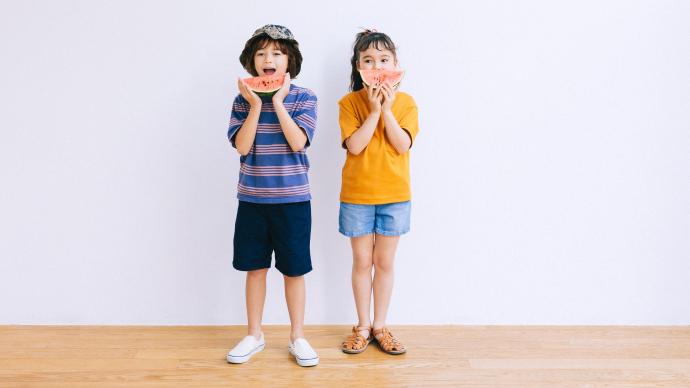
As children, we had a lot of fantasies about growing up, such as when will we be able to wear those beautiful clothes from our parents in the closet?
Parents' interest in dressing also affects children's aesthetic training.
Clothing often conveys people's thoughts and feelings inadvertently, and a person's sense of clothing style also sprouts in childhood. Some parents feel that a child's focus on appearance can become vain or narcissistic. In fact, cultivating children's awareness of proper dress from an early age will help enhance their self-confidence and self-esteem, and to a certain extent, will help children improve their self-acceptance and social skills.
Some parents feel that a child's focus on appearance can become vain or narcissistic. In fact, cultivating children's awareness of proper dress from an early age will help enhance their self-confidence and self-esteem, and to a certain extent, will help children improve their self-acceptance and social skills.
How many people remember the fun of dressing up when they were kids? Allowing self-dressing is one way to encourage children to build themselves. Parents try not to let their own opinions mixed in, and let their children play more by themselves.
Try to avoid saying "you should dress like this" directly. Commenting on or challenging a child's clothing choices may be seen as a criticism of their overall appearance. Especially when the child is wearing clothes, parents can use some picture examples and make suggestions in combination with social etiquette, and communicate with the child the reasons for the choice, which is conducive to reaching a consensus between parents and children.
For parents, matching clothes for children is not easy. Although children may not be interested in so-called fashion trends. But trends are a great tool for parents to encourage their kids to try new things and express themselves with some trending information. For example, in 2022, the clothing will be full of flowers, and children's clothing will also be decorated with a large number of prints. But you don't always have to jump headfirst into trends. Parents can guide their children to choose a simple style, with a plain coat, or clothing with printed elements.
For example, in 2022, the clothing will be full of flowers, and children's clothing will also be decorated with a large number of prints. But you don't always have to jump headfirst into trends. Parents can guide their children to choose a simple style, with a plain coat, or clothing with printed elements.
Parents are their children's best teachers. When it comes to dressing, parents can set a good example for them—keep it appropriate, or keep it stylish and fun, so your child will be more likely to follow your advice on dressing.
Parents are also stylists for their children, especially when they are young. Teaching kids to build their own style isn't easy, especially if parents don't like dressing up themselves. However, parents have a responsibility to help their children develop good habits, including how to choose clothes independently.
Color is an entry into building style. When children begin to show signs of personality, they tend to be attracted to certain colors, shapes, or patterns. Children match colors from their own wardrobes, from which they build up some basic knowledge about colors, such as complementary and contrasting colors, and understand how colors match the occasion. They can also feel the joy of creation. As a parent, don't ignore why your child dresses like this. Maybe the child likes a hat that covers most of his face because he is shy; maybe he likes to wear a certain pair of shoes because he wants to wear the same style as his best friend. After understanding why, parents can also offer their children some similar options, such as flip-flops that can be turned into sandals in a similar style, and pajama pants that can transition to cotton sweatpants.
As a parent, don't ignore why your child dresses like this. Maybe the child likes a hat that covers most of his face because he is shy; maybe he likes to wear a certain pair of shoes because he wants to wear the same style as his best friend. After understanding why, parents can also offer their children some similar options, such as flip-flops that can be turned into sandals in a similar style, and pajama pants that can transition to cotton sweatpants.
Through their children's clothing preferences, parents can also gain insight into their personalities. There are often differences in dressing, and parents need to always remind themselves: try not to unilaterally decide what your child wears, which may arouse the child's rebellious heart.
Parents' interest in dressing also affects children's aesthetic training.
Clothing often conveys people's thoughts and feelings inadvertently, and a person's sense of clothing style also sprouts in childhood.
 Some parents feel that a child's focus on appearance can become vain or narcissistic. In fact, cultivating children's awareness of proper dress from an early age will help enhance their self-confidence and self-esteem, and to a certain extent, will help children improve their self-acceptance and social skills.
Some parents feel that a child's focus on appearance can become vain or narcissistic. In fact, cultivating children's awareness of proper dress from an early age will help enhance their self-confidence and self-esteem, and to a certain extent, will help children improve their self-acceptance and social skills.How many people remember the fun of dressing up when they were kids? Allowing self-dressing is one way to encourage children to build themselves. Parents try not to let their own opinions mixed in, and let their children play more by themselves.
Try to avoid saying "you should dress like this" directly. Commenting on or challenging a child's clothing choices may be seen as a criticism of their overall appearance. Especially when the child is wearing clothes, parents can use some picture examples and make suggestions in combination with social etiquette, and communicate with the child the reasons for the choice, which is conducive to reaching a consensus between parents and children.
For parents, matching clothes for children is not easy. Although children may not be interested in so-called fashion trends. But trends are a great tool for parents to encourage their kids to try new things and express themselves with some trending information.
 For example, in 2022, the clothing will be full of flowers, and children's clothing will also be decorated with a large number of prints. But you don't always have to jump headfirst into trends. Parents can guide their children to choose a simple style, with a plain coat, or clothing with printed elements.
For example, in 2022, the clothing will be full of flowers, and children's clothing will also be decorated with a large number of prints. But you don't always have to jump headfirst into trends. Parents can guide their children to choose a simple style, with a plain coat, or clothing with printed elements.Parents are their children's best teachers. When it comes to dressing, parents can set a good example for them—keep it appropriate, or keep it stylish and fun, so your child will be more likely to follow your advice on dressing.
Parents are also stylists for their children, especially when they are young. Teaching kids to build their own style isn't easy, especially if parents don't like dressing up themselves. However, parents have a responsibility to help their children develop good habits, including how to choose clothes independently.
Color is an entry into building style. When children begin to show signs of personality, they tend to be attracted to certain colors, shapes, or patterns. Children match colors from their own wardrobes, from which they build up some basic knowledge about colors, such as complementary and contrasting colors, and understand how colors match the occasion. They can also feel the joy of creation.
 As a parent, don't ignore why your child dresses like this. Maybe the child likes a hat that covers most of his face because he is shy; maybe he likes to wear a certain pair of shoes because he wants to wear the same style as his best friend. After understanding why, parents can also offer their children some similar options, such as flip-flops that can be turned into sandals in a similar style, and pajama pants that can transition to cotton sweatpants.
As a parent, don't ignore why your child dresses like this. Maybe the child likes a hat that covers most of his face because he is shy; maybe he likes to wear a certain pair of shoes because he wants to wear the same style as his best friend. After understanding why, parents can also offer their children some similar options, such as flip-flops that can be turned into sandals in a similar style, and pajama pants that can transition to cotton sweatpants.Through their children's clothing preferences, parents can also gain insight into their personalities. There are often differences in dressing, and parents need to always remind themselves: try not to unilaterally decide what your child wears, which may arouse the child's rebellious heart.
Related Posts